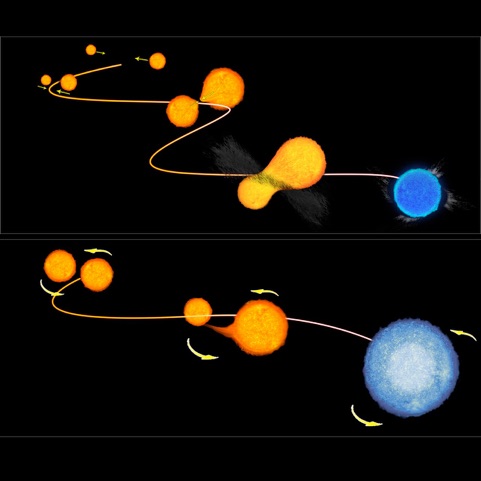Blue Stragglers
"baby" stars in old stellar clusters
Blue Stragglers
"baby" stars in old stellar clusters
In 1953, astronomer Allan Sandage found a puzzling new population of stars which seemed to go against the rules of stellar evolution in globular clusters. Sandage detected hot young blue stars in the globular cluster Messier 3 (M3), and subsequently in other globular clusters. He dubbed them "stragglers" because they looked like they were trailing or left behind by other blue stars that long ago evolved to the red giant stage. The presence of these (apparently) young stars in a globular cluster was quite strange, since star formation essentially stopped in globular clusters 13 billion years ago, and astronomers therefore expect to find only old stars.
The formation of Blue Stragglers

After almost 60 years of investigation, blue stragglers are now thought to arise in "twin systems" where two stars form a tight binary. In such a pair, the less massive star would act as a "vampire", siphoning fresh hydrogen from its more massive companion star. With the new fuel supply the smaller star heats up, growing bluer and hotter - behaving like stars that are earlier in their evolution. Another possibility are stellar encounters which are nearly head-on collisions, in which the stars might actually merge, mixing their nuclear fuel and "re-stoking" the fires of nuclear fusion. Because of their formation mechanism, Blue straggler stars would have a mass about twice the mass of the cluster's individual stars.

This illustration shows the two ways that Blue Stragglers - or "rejuvenated stars" - in globular clusters form.
The upper illustration shows the collision model, where two low-mass stars in a overcrowded environment experience a head-on collision, combining their fuel and mass to form a new, single, hot (hence blue) and seemingly young star.
The lower illustration depicts the "vampire" model, consisting of a pair of stars where the lower-mass object drains its heavier companion of hydrogen, that fuels its rebirth.
Why do collisions and vampirism rejuvenate stars?
The life-stage of a star is essentially driven by the amount of unspent fuel (hydrogen) remaining in its centre. Adding fresh hydrogen from the outside, either by a collision or by transferring mass from a binary companion in the stellar core, prolongs the life of the star and makes it look more youthful (blueness and brightness being the attributes of younger stars).